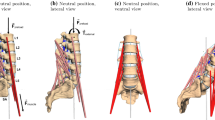Summary
The main objective of this study was the assessment of the influence of geometrical factors on the behavior of lumbar segments. To this end, a three-dimensional, parameterized, finite element model of the lumbar spine was used, and the results were compared with in-house experimental results and with the few published experimental results available concerning either the geometry of the tested samples or the differences observed at different vertebral levels. Furthermore, in order to appreciate the relative importance of the geometry, the influence of the variation of some other parameters was studied, such as the orientation of the facet joints, the gap between the articular processes, and the Young's modulus of the disk fibers. As a first approach, a series of computations was carried out in order to evaluate the role of geometry in the mechanical behavior differences observed at different levels. It has been found that geometrical factors do exert a noticeable influence on the behavior of the spine, especially those which interfere with the dimensions of the intervertebral disk.
Similar content being viewed by others
References
Ahmed AM, Abdul MA, Duncan NA, Burke DL (1990) The effect of facet geometry on the axial torque response of lumbar motion segments. Spine 15:391–401
Beaudoin L (1983) Caractérisation mécanique des ligaments de la colonne vertébrale. M Sc Thesis, University of Montréal
Chazal J, Gaurel G, Escande G, Guillot M, Tanguy A, VanDeuville G (1985) Biomechanical properties of spinal ligaments and a histological study of the supraspinous ligament in traction. J Biomech 18:167–176
Evans JH, Nachemson AL (1968) Some mechanical properties of the third lumbar interlaminar ligament. J Biomech 1:211–220
Farfan MF, Cossette JW, Robertson JW, Wells RV, Kraus H (1980) The effects of torsion in the intervertebral joints: the role of torsion in the production of disc degeneration. J Bone Joint Surg [Am] 25:468–497
Goel VK, Kim YE, Lim TH, Weinstein JN (1988) An analytical investigation of the mechanics of spinal instrumentation. Spine 13:1003–1011
Lavaste F (1980) Biomécanique du rachis dorso-lombaire. In: Deuxiémes journées d'orthopédie de la pitié. Masson, Paris, pp 19–23
Lavaste F (1990) Contribution à l'étude du comportement biomécanique du rachis dorsolombaire. DSC thesis, ENSAM, Paris
Lavaste F, Asselineau A, Diop A, Grandjean JL, Laurain JM, Skalli W, Roy-Camille R (1990) Protocole expérimental pour la caractérisation mécanique de segments rachidiens et de matériels d'ostéosynthèse dorso-lombaires. Rachis 2:435–446
Lavaste F, Skalli W, Robin S (1991) Three-dimensional modeling of the lumbar spine: an application to the study of posterior fixation devices. VII International Congress of Biomechanics, Perth, Australia, December 9–13
Lavaste F, Skalli W, Robin S, Roy-Camille R, Mazel C (1992) 3D geometrical and mechanical modelling of the lumbar spine. Biomech 25:1153–1164
Markolf KL (1972) Deformation of the thoracolumbar intervertebral joint in response to external loads. J Bone Joint Surg [Am] 56:675–687
Martin F, Jayle T, Guyon F, Lavaste F (1990) Comportement mécanique du rachis lombaire, etude expérimentale. XV Congrés de la Société de Biomécanique, Cluny, September 18–19
Panjabi MM, Brand RA, White AA (1976) Three-dimensional flexibility and stiffness properties of the human thoracic spine. J Biomech 9:195–192
Panjabi MM, Yamamoto I, Oxland T, Crisco J 81989) How does posture affect coupling in the lumbar spine? Spine 14: 1002-1011
Robin S, Skalli W, Lavaste F (1991) Modélisation tridimensionelle du rachis lombaire: application à l'étude d'dune lésion discale et d'une restauration chirurgicale par fixation postérieure. XII Congrès de la Société de Biomécanique, Lille, November 8–9
Scole PV, Linton AE, Latimer B, Levy ME, Digiovanni BF (1988) Vertebral body and posterior element morphology: the normal spine in middle life. Spine 13:1082–1086
Shirazi-Adl A, Shrivastava SC, Ahmed AM (1984) Stress analysis of the lumbar disc-body unit in compression: a three dimensional non linear finite element study. Spine 9:120–134
Shirazi-Adl A, Ahmed AM, Shrivastava SC (1986) Mechnical response of a lumbar motion segment in axial torque alone and combined with compression. Spine 11:914–927
Skalli W, Robin S, Lavaste F, Dubousset J (1992) A biomechanical analysis of short segment spinal fixation using a 3D geometrical and mechanical model. Spine 18:1–10
Tencer AF, Ahmed AM, Burke DL (1982) Some static mechanical properties of the lumbar intervertebral joint, intact and injured. J Biomech Eng 104:200–209
Ueno K, Liu YK (1987) A three-dimensional non-linear finite element model of the lumbar inervertebral joint in torsion. J Biomech Eng 109:200–209
Author information
Authors and Affiliations
Rights and permissions
About this article
Cite this article
Robin, S., Skalli, W. & Lavaste, F. Influence of geometrical factors on the behavior of lumbar spine segments: A finite element analysis. Eur Spine J 3, 84–90 (1994). https://doi.org/10.1007/BF02221445
Issue Date:
DOI: https://doi.org/10.1007/BF02221445




